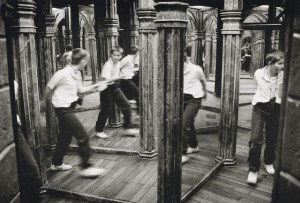Dementing Augmented Reality: How Future Activists Will Break People Out Of Their Digital Trances
It’s less than two months prior to the “End of the World†on December 21, 2012. Terence McKenna predicted that we would see a spike of “infinite novelty†at the end of the year, when the ambient strangeness in the world hit the point of no return, the Omega Point beyond which we entered post-historical hyperspace.
With not much longer to go, it’s clear to me that he was right, but that he probably “confused the planes,†as it were. The model applies perfectly to the world of information and data: just check Facebook and Twitter and you’ll see what he meant. Meanwhile, down here in the physical world, it’s the same haves-and-have-nots, except there’s a lot less rainforest and everybody’s glued to screens checking f*king Facebook, lost in the infinite hallucinatory kaleidoscope.
“This is the generation who grew up and forgot to lead their lives,†caws Borgia Ginz in Derek Jarman’s Jubilee. “They were so busy watching my endless movie… I sucked and sucked and sucked. The media became their only reality. And I owned their world of flickering shadows.†Of course, the greatest triumph of social media is that now the “powers that be†have tricked us into hypnotizing each other for them, and volunteering all of our data in the meantime.
Over the next ten years I can imagine this trend only increasing. As physical reality becomes grimmer, our endless virtual realities will only become more and more complex and enticing. As we will likely face increasingly vicious oil wars in the countdown to Peak Oil — and, towards the middle of the century, water wars—those who are privileged enough to do so will become more and more disassociated from the physical world, vanishing into the comforting data ether, in which the illusion of participation takes primacy over actual contact with the world.
Soon we will have augmented reality, and behind our glasses or held-up phones we will move through the reality tunnels that Google, Facebook and their successors will lay out for us, all with ads targeted to our increasingly focused consumer desires. Why bother dealing with reality when you can walk through a personally tailored data tunnel instead? Now this is worrying, because as if people weren’t drugged and hypnotized enough, now we’re going to have this level of immersive corporate hallucination to deal with.
So without further ado, and as a gift to the poor bastards of the future, I present four ways to troll augmented reality.
- 1. Tunnel Swapping. No, this is not a sexual fetish. It’s a great opportunity for applying the old Gurdjieffian shock: taking people’s data feeds and simply swap them with those of others. Imagine the augmented reality feed of an investment banker swapped with that of a drug dealer. A Republican demagogue’s switched with a welfare mother’s. The endless possibilities for the bridging of social opposites and antimonies should be more than apparent.
- 2. Dataleaks. While we currently live in the world of Wikileaks and the celebrity sex tape, when augmented reality rolls out it’s inevitable that we’re going to see leaks from people’s personal feeds. The unfairly panned 1996 movie Strange Days has this concept at the center of its plot, and is worth a repeat viewing in the context of new augmented reality technologies.
- 3. Détournement. Old tactics never die, they just get refreshed for new technology. Détournement is the Situationist practice of changing the words in advertisements and other media to show what they “really†mean. Imagine having your data feed compromised and suddenly seeing the physical world relabeled. Instead of seeing prices and buy links on those Nike shoes you just walked by, you’re shown the wages and life expectancy of the sweatshop children who made them. Taglines on billboard supermodels are replaced with text reading YOU’RE TOO UGLY TO GET TO HEAVEN. Candidates in political debates and advertisements are suddenly shown wearing not suits but racecar driver-style jumpsuits bearing the logos of all of their corporate sponsors.
- 4. Reclaiming the Physical. Faced with a totally controlled, monitored and owned online world, in which every utterance is immediately scanned and filed away, many have yet to make the connection that the best solution may not be running Tor and eighteen proxies, but writing things down on paper and talking face-to-face. Remember the mail? Remember conversations? Yeah, those still exist. Want to shake somebody out of their online trance? Send them a letter. Send them art. Want to record something that will last longer than a few seconds on Facebook or Twitter? Write a book. The physical world didn’t go anywhere. In fact, physical artifacts and experiences have only grown in totemic power the more we’ve pushed them away.
Further ideas will undoubtably present themselves in spades to the creative reader. Under the datafeed, the beach!
Jason Louv is the author of Queen Valentine
and editor of Thee Psychick Bible, Ultraculture Journal and Generation Hex. He currently helms the group futurist blog Ultraculture . @jasonlouv ( https://twitter.com/jasonlouv )


